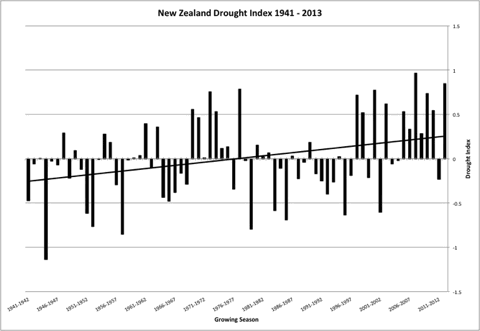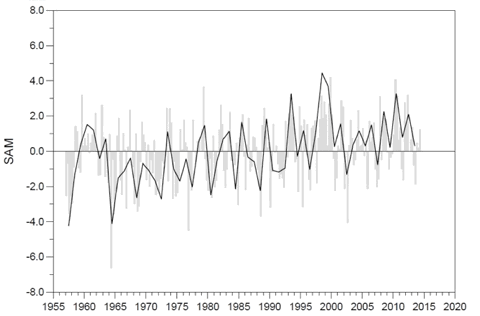In this guest post Jim Salinger (currently working in Italy, but soon to return to these shores), takes a look at the climate influences on last year’s severe New Zealand drought. It first appeared on The Conversation.
 Over 2012 and 2013, parts of New Zealand experienced their worst drought in nearly 70 years. Drought is the costliest climate extreme in New Zealand; the 2012-2013 event depressed the country’s GDP by 0.7-0.9%. The drought of 1988-1989 affected 5,500 farms, pushing some farmers to the wall. But what does a climate-changed future hold?
Over 2012 and 2013, parts of New Zealand experienced their worst drought in nearly 70 years. Drought is the costliest climate extreme in New Zealand; the 2012-2013 event depressed the country’s GDP by 0.7-0.9%. The drought of 1988-1989 affected 5,500 farms, pushing some farmers to the wall. But what does a climate-changed future hold?
Recent evidence confirms that New Zealand on the whole is getting dryer. And we’re beginning to understand why — increasing greenhouse and ozone-depleting gases are driving changes in the atmosphere, with impacts far beyond New Zealand.
A history of drought
Agricultural drought is occurs when there is not enough moisture in the soil available to support crop and pasture growth. It is usually fairly extensive over significant parts of the country.
In March this year we reported that there is distinct trend towards increased agricultural drought since 1941, in four (80%) out of the five agricultural drought regions. There is a trend toward a summer drying in all of these regions except the west of the North Island. The overall trend for New Zealand agricultural drought is shown in the diagram below.

New Zealand agricultural drought index 1941-2013 averaged over the country. The bars represent individual years, and the straight line shows the 72-year trend. Positive values mean a droughtier year, and negative values mean a wetter year for agriculture.
What’s causing the big dry?
Two recent reports shed light on why drought is increasing in New Zealand.
On 9 September the Geneva based World Meteorological Organization (WMO), a United Nations body, announced that the amount of greenhouse gases in the atmosphere reached a new record high in 2013, propelled by a surge in levels of carbon dioxide during between 2012 and 2013.
Last year the concentration of CO2 in the atmosphere reached 142% of the pre-industrial era (1750). Methane levels reached 253% and nitrous oxide 121%. Between 1990 and 2013 there was a 34% increase in radiative forcing — the warming effect on our climate — because of long-lived greenhouse gases such as carbon dioxide (CO2), methane and nitrous oxide.
These have warmed the climate. Over the last 72 years mean annual global and New Zealand temperatures have increased by 0.6 and 0.7C respectively.
And on September 11 a new report, with Dr Olaf Morgenstern of the NZ National Institute of Water and Atmospheric Research as a reviewer recognised the role of ozone depletion in drying parts of southern Australia.
The same link has been established in New Zealand. Ozone depletion affects an atmospheric pattern known as the Southern Annular Mode, or SAM. These changes are particularly pertinent as the spring time stratospheric Antarctic ozone hole peaked this year at 24 million square kilometres on September 11.
SAM describes the movement of the westerly wind belt that circles the Southern Oceans between the South Island of New Zealand and Antarctica.
In its positive phase, SAM causes the belt of strong westerly winds to contract towards Antarctica. There are weaker westerly winds than normal over the South Island with higher pressures, and less cold fronts crossing New Zealand. The opposite occurs in the negative phase of SAM with the westerly wind belt expanded north towards New Zealand and the passage of more westerly cold fronts.
The positive SAM has also been linked to decreasing rainfall in south western Australian, and the recent record-breaking expansion of Antarctic sea ice.

Index of the Southern Annular Mode, 1957 – 2013. Source: British Antarctic Survey, Cambridge, UK.
The graph of SAM over the last 56 years shows a trend towards a more positive index, averaging around -3 at the beginning of the record to +1 in recent years. Several researchers have now shown that this increase in SAM is strongly associated with stratospheric ozone depletion.
Less rain, more evaporation
Recent work has revealed that changes in SAM in New Zealand have resulted in a weakening of moisture laden westerly winds during the summer, and increased high pressures over the North Island with less rain.
The warming trend caused by increasing greenhouse gases has led to more moisture loss to the atmosphere from plants because of increased evapotranspiration. This is where plants “breathe out” into the air moisture that is stored in the soil.
The hotter it is, the more moisture plants pump out into the atmosphere. These two effects — less rainfall and more water loss from the soil have resulted in our climate becoming droughtier for agricultural activities.
Bringing back the rains
The stratospheric ozone layer is now protected by the Montreal Protocol — an international treaty to protect the ozone layer by phasing out production of ozone-depleting substances signed in 1989. Unfortunately it has not prevented some impacts on New Zealand climate — but at least these impacts will be slowed then reversed in coming decades. The Antarctic stratospheric ozone hole peaked in 2006 at around 30 million square kilometres.
However there is no such robust agreement to curb the growth of greenhouse gases in the atmosphere. The World Meteorological Organisation has called for even greater urgency for concerted international action against accelerating and potentially devastating climate change.
Any future New Zealand government must front up to New Zealand taking full leadership in any international agreements to rapidly halt and reverse the growth of greenhouse gases, as the country did with the Montreal Protection to protect the stratospheric ozone layer twenty five years ago. After all, these trends are now affecting the country’s land-based industries vital for its wealth.
![]()
This article was originally published on The Conversation. Read the original article.

As drought and heat increase, streams become more valuable and an important asset. It is important that farmers look after the streams and keep them clean and shaded so that in a drought they keep flowing with clean water and do not turn into a toxic ditch. http://www.climateoutcome.kiwi.nz/streams-a-vital-resource.html
Good page Bob. I experienced some cases of the opposite character – water courses so overgrown (with willow) that both motion and life had ceased. Yet there were people at hand intent on restoring some of them with inspiring results.
You might want to remove one of the “have”s from this:
“we have already have experienced mild ” near the bottom of the paragraph under the image of the soil covered hand.